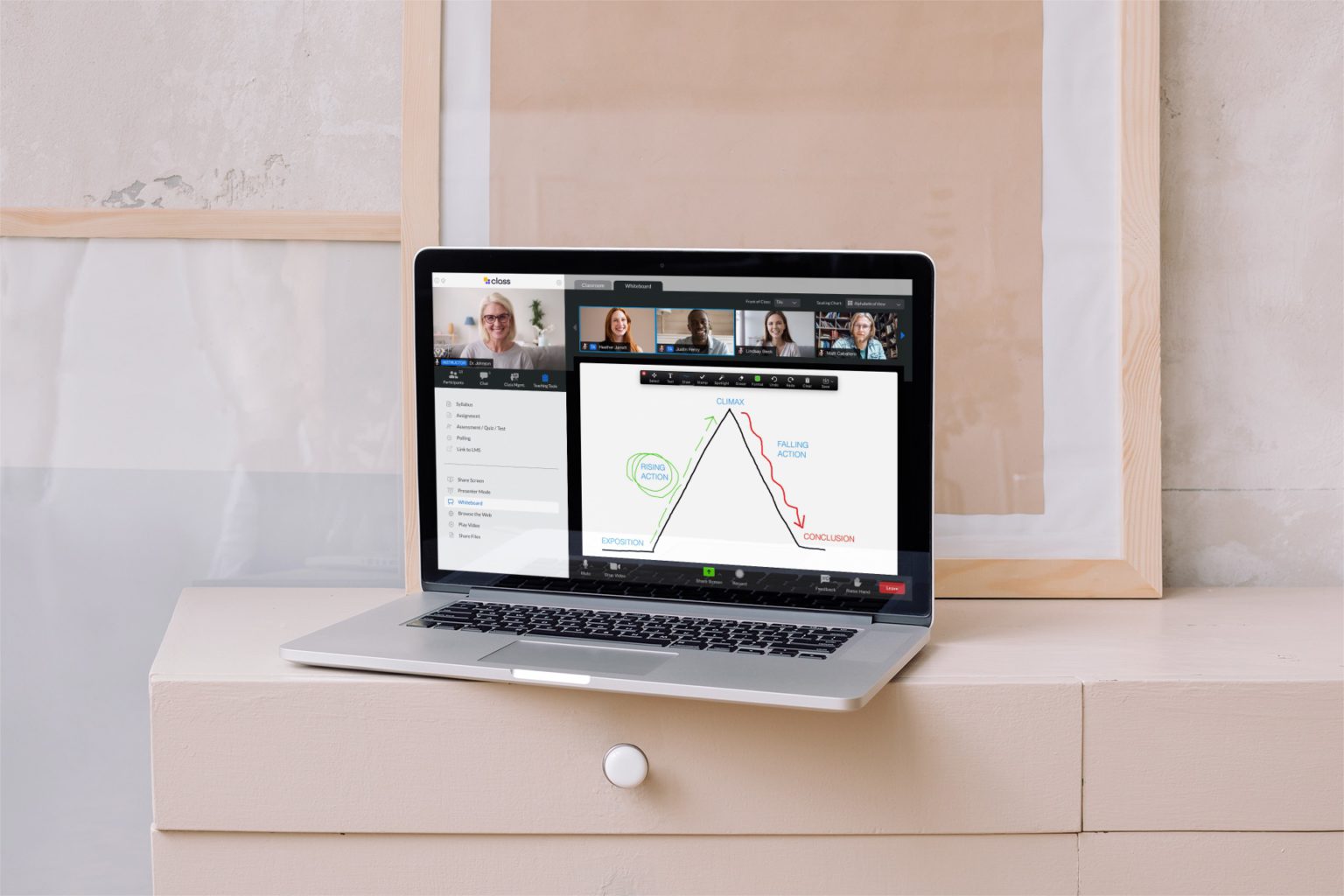
Class is the next generation virtual classroom for K-12, higher education, government agencies, and the workplace. Contact us today to schedule your live demo and see Class in action.

Class is the next generation virtual classroom for K-12, higher education, government agencies, and the workplace. Contact us today to schedule your live demo and see Class in action.

Professors in higher education may have had more prior experience with virtual teaching than their K-12 counterparts, but that doesn’t mean they have not had to quickly adapt and adopt new strategies for effective virtual or hybrid learning.
Today’s online college courses are far less likely to be asynchronous and far more likely to be both synchronous and hybrid, meaning professors are often simultaneously interacting with students in the classroom and online. College virtual learning looks different these days. But professors are getting the hang of it. Here we take a look at three virtual teaching strategies for professors that you can easily use in your own classrooms.
Breakout rooms are a widely used tool in the virtual or hybrid learning environment. Tools like Class make it easy to put students into groups with the tap of a button. Groups can either be assigned randomly or instructors can assign team members to specific rooms.
But, while it’s very easy to set up breakout rooms either ahead of time, or at the moment, it pays to practice and work out any kinks, says Arash Fayz, the founder and executive director of LA Tutors, an international private tutoring company.
Fayz shares an experience he had where an acquaintance who is a physics professor invited him and a few others to sit in on a mock Zoom class to help her practice different breakout room configurations. “She familiarized herself with the technology and the options for different group sizes and made sure she knew how to move freely from group to group,” he says. This is an important way to avoid technical issues and gain comfort with the options available.
The online, hybrid teaching environment is different and often requires professors to modify their traditional classes and lectures for the online format. “Attending class from home means more distractions and more opportunities to tune information out, so staying short, snappy and engaging is key to a successful virtual class,” says Fayz. Quick transitions, including breakout rooms, can help keep students focused and engaged.
Don’t just use breakout rooms for course-related activities, though, Fayz suggests. “While socialization and emotional support may not normally be as big a part of a college curriculum as it is in an elementary school setting, it is an important part of the college experience, so building in ways to help students cultivate those relationships and skills is worthwhile, even if it means sacrificing a tiny bit of class time,” he says.

One perhaps unanticipated benefit of college virtual learning is the ability to easily and inexpensively expose students to experts of all kinds. Prior to the pandemic, guest speakers were common on campuses but generally presented in person, requiring travel time, finding places to park and settle that are often in short supply, and navigating sometimes very large campuses to find the right room.
Now speakers can easily engage in real-time from the comfort of their home offices, or wherever they happen to be. This provides benefits to them as well as students who appreciate the opportunity to learn directly from experts in their fields.
Gilbert Michaud, Ph.D., is a professor at Ohio University where he teaches in a public affairs program. Michaud has used guest speakers as part of an engagement strategy that he’s implemented for his hybrid courses. He holds mandatory sessions with guest speakers on course-related topics. This has allowed him to invite speakers from outside of his school’s region — people who might not otherwise have been available to present in person.
“Making these guest speaker sessions mandatory has helped enhance the cohort learning culture in a virtual environment,” he says. “Further, I ask students for reflections on these guest speakers through a formal assignment, which has enhanced participation and engagement with the speakers.”
Virtual learning doesn’t have to be all business all the time. In fact, effective virtual teaching can benefit from taking a break from lectures to have a little fun.
Tik Tok in the classroom? Absolutely, says Lee M. Pierce, PhD., an assistant professor of communication at SUNY Geneseo and host of the RhetoricLee Speaking podcast. “If you’re a teacher and you aren’t Tik Toking then you’re making a big mistake,” she says. Tik Tok, she points out, “is the fastest growing platform for students and, although it has issues, it has an amazing #teachertok collective.”
Sorden recommends assigning videos to students as discussion prompts and asking them to make their own videos and post them as projects, asking other students to watch them. “If your students don’t use Tik Tok or don’t have access, then ask them to submit an alternative assignment that you can share with the class,” she suggests.
Teachers can also devise their own game-like activities.
Alexa Sorden is the founding principal of Concourse Village Elementary School (CVES) in the South Bronx. At CVES, Sorden shares, the PE teacher organized a school-wide fitness and coding challenge using the STEM learning tool Unruly Splats. “It was designed so that students could participate across remote and hybrid learning,” she says. “Some of my teachers encourage attendance by allowing the kids who have perfect attendance to play Among Us, a phone game that’s all the rage with kids right now,” she adds.
The virtual teaching strategies teachers, administrators, and schools are learning during virtual learning are likely to serve them well even after the pandemic has passed. Through online assessment and input from students, schools are learning what works well and where they may need to make some tweaks.
In addition to their own assessments of how well various types of virtual teaching strategies are working, seeking input from students and others can help keep professors and administrators stay informed. “We’re using online assessments more than ever, which is improving how we collect this information and assess learning trends,” says Sorden. “As a result, we may want to continue this technology practice even when we return full time to the classroom,” she says. We have an article full of additional tips for teaching hybrid courses in higher ed.

Class is the next generation virtual classroom for K-12, higher education, government agencies, and the workplace. Contact us today to schedule your live demo and see Class in action.

Class is the next generation virtual classroom for K-12, higher education, government agencies, and the workplace. Contact us today to schedule your live demo and see Class in action.
Get our insights, tips, and best practices delivered to your inbox

Sign up for a product demo today to learn how Class’s virtual classroom powers digital transformation at your organization.

Features
Products
Integrations